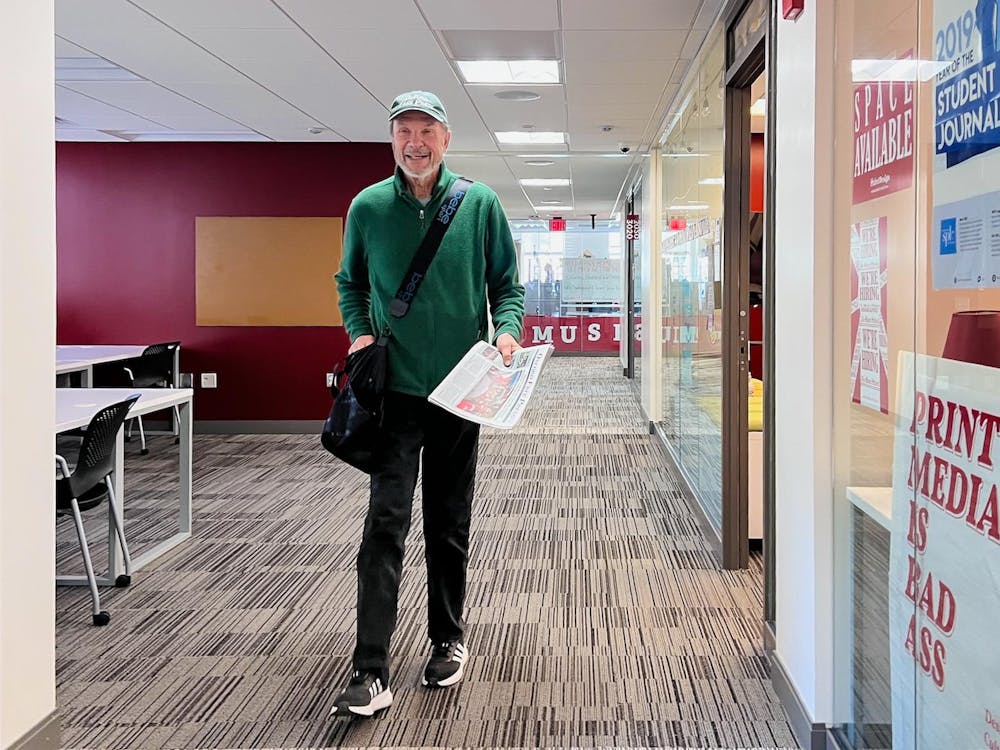About six years ago, Stephen Gavazzi was conducting a marriage family therapy session in Columbus when a strange idea occurred to him.
The husband in the session was yelling at his wife about something she'd done before they were married. That argument reminded Gavazzi of the dysfunctional relations that often arise between colleges and college towns.
"I thought to myself, 'Oh, isn't that interesting? Campus-community relationships are just like marriages.'"
After that observation, he began to consider the details.
Then, Gavazzi thought: "Wait a second -- maybe there really is something there."
The idea resulted in the "Town-Gown Survey" survey which circulated around Oxford this month.
Gavazzi, a professor of human development and family science at Ohio State-Mansfield, said that universities and towns across the country deal with the positives and negatives of being in close proximity to one another, just like couples do in marriages.
"This whole model was built on that kind of epiphany experience," Gavazzi said. "At the end of the day, it's always about relationships."
Gavazzi worked closely with two colleagues, Jeff Martin, a professor at Clemson University and Mike Fox, a professor at Mount Allison University in Canada, on some cursory work regarding town-gown relationships.
"There's one big difference between community relationships and marriages: in a town-gown relationship you can't get a divorce," Gavazzi said. "You're stuck with each other, so why not make the best of it?"
After presenting their work at multiple conferences, Gavazzi and his colleagues were met with the question of how these relationships can be measured. Looking at some older family therapy models, they discovered healthy marriages result from high effort and high comfort.
"What everybody wants in a marriage is a harmonious relationship, and those are characterized by high effort and high comfort," Gavazzi said. "Of course, that's a moving target; you have to maintain that effort in order to maintain that comfort."
Enjoy what you're reading?
Signup for our newsletter
Based on these observations, Gavazzi created the survey which is now being used to measure Oxford and Miami's relationship. "The Optimal Town-Gown Assessment" is a major part of the The Ohio College Initiative Alcohol and Other Drug (AOD) Pilot Project in which Miami, Cleveland State and Otterbein University were chosen to participate.
This project's goal is to reduce student alcohol and drug use on campuses by restricting alcohol advertising, enforcing policies and laws and creating a "health-promoting environment."
About ten schools submitted applications, but the chosen three, including Miami, were picked because each had an existing town-gown council to lead the project.
Miami's town-gown initiative team (TGIT) is led by Oxford mayor Kate Rousmaniere and Miami dean of students Mike Curme, along with around eight other representatives from both the town and university.
"The TGIT was designed to serve. There are many long-standing and effective town-gown partnerships that have been doing great work for many decades," Curme said. "We seek to better understand the goals of these existing efforts, and then help coordinate and support these efforts."
Mayor Rousmaniere said two of the challenges the city of Oxford faces are housing issues and student's alcohol use and behavior. The latter explains the additional questions about student drug and alcohol use on the town-gown survey.
"The relationship between the college and the town is notoriously complicated," Rousmaniere said. "Usually, the problem has to do with a lack of communication between the two institutions."
This survey hopes to illuminate both the strengths and weaknesses of the town-gown relationship and, in doing so, improve communication between the two.
"Everything that has to do with town-gown relationships revolves around the students, and that's for better and for worse," Gavazzi said.
In Oxford, the student presence demands to be felt, particularly on weekends at bars and restaurants in Uptown. Recently, there has also been tremendous strain on Oxford EMTs and police, primarily from students.
At the same time, college students positively contribute to the Oxford community by supporting local businesses and volunteering at nearby schools.
"The relationship between Miami and Oxford will always take work," Jessica Greene, executive director of the Oxford Visitors Bureau, said. "All good, long-term relationships require this effort. In my opinion, right now we are embarking on a period of better communication and attempting to work together."
Once the survey closes and results are collected, Miami's town-gown initiative team will analyze the data and consider different courses of action to improve the relationship between Miami and Oxford.
About 15 universities and towns have used this survey, which is typically repeated every two years to determine if progress has been made. The survey was open to Oxford residents, faculty, staff and Miami students.
"I think it's a very important initiative that Miami and Oxford are doing," Gavazzi said. "The steps being taken here bode well for a continuing strengthening of the relationship between Miami and Oxford, and I think it's admirable."
The survey closed Wednesday, Nov. 22, and results are now being analyzed.
dattilec@miamioh.edu



